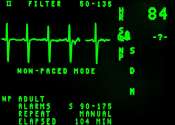Researchers discover how heart arrhythmia occurs
Researchers have discovered the fundamental biology of calcium waves in relation to heart arrhythmias.
Jan 19, 2014
0
0
Researchers have discovered the fundamental biology of calcium waves in relation to heart arrhythmias.
Jan 19, 2014
0
0

Results from rhesus macaques provide solid ground for a first-in-human investigation of heart repair with stem cell-derived engineered heart muscle. The study is a milestone for the clinical application of the "heart patch" ...
Jan 29, 2025
0
47

A heart attack is a life-threatening condition, with patients remaining at risk of premature death long after the actual attack—50% to 60% of patients die subsequently as a result of sudden cardiac death, triggered by cardiac ...
Jun 28, 2024
0
59

Wireless implantable cardioverter-defibrillators (ICDs) eliminate the lead-related complications that come with a wired ICD, but they are unsuitable for patients with ventricular tachycardia, when the heart beats too quickly, ...
May 18, 2024
0
17

To fill gaps in knowledge of yellow fever (YF), a group of researchers in Brazil affiliated with the Department of Pathology at the University of São Paulo's Medical School (FM-USP), Hospital das Clínicas (HC, the hospital ...
Dec 19, 2023
0
24

The iHEART simulator is a mathematical and computational model of the human heart entirely developed at Politecnico di Milano and designed for studying coronary artery disease. This is the focus of research published in Scientific ...
Sep 18, 2023
0
87

People who find it difficult to find time to exercise during a busy work week may concentrate their moderate-to-vigorous physical activity to one to two days of the week or weekend.
Jul 18, 2023
0
102

Atrial and ventricular fibrillations are dangerous heart arrhythmias that claim millions of lives each year. Current treatment for them is a high-energy defibrillation shock that can be intensely painful and lead to further ...
Dec 13, 2022
0
66

Electronic gaming can precipitate life-threatening cardiac arrhythmias in susceptible children whose predisposition may have been previously unrecognized, according to a new report in Heart Rhythm. The investigators documented ...
Oct 11, 2022
0
101

A recent study published in Nature Genetics identified 10 new genetic regions associated with Brugada syndrome, a cardiac arrhythmia disorder associated with sudden death in young adults.
Mar 31, 2022
0
385

Cardiac dysrhythmia (also known as arrhythmia and irregular heartbeat) is any of a large and heterogeneous group of conditions in which there is abnormal electrical activity in the heart. The heart beat may be too fast or too slow, and may be regular or irregular.
Some arrhythmias are life-threatening medical emergencies that can result in cardiac arrest. Others cause symptoms such as an abnormal awareness of heart beat (palpitations), and may be merely annoying. These palpitations have also been known to be caused by atrial/ventricular fibrillation, wire faults, and other technical or mechanical issues in cardiac pacemakers/defibrillators. Still others may not be associated with any symptoms at all, but may predispose the patient to potentially life threatening stroke or embolism.
Some arrhythmias are very minor and can be regarded as normal variants. In fact, most people will on occasion feel their heart skip a beat, or give an occasional extra strong beat; neither of these is usually a cause for alarm.
Proarrhythmia is a new or more frequent occurrence of pre-existing arrhythmias, paradoxically precipitated by antiarrhythmic therapy, which means it is a side effect associated with the administration of some existing antiarrhythmic drugs, as well as drugs for other indications. In other words, it is a tendency of antiarrhythmic drugs to facilitate emergence of new arrhythmias.
The term sinus arrhythmia refers to a normal phenomenon of mild acceleration and slowing of the heart rate that occurs with breathing in and out. It is usually quite pronounced in children, and steadily decreases with age. This can also be present during meditation breathing exercises that involve deep inhaling and breath holding patterns.
This text uses material from Wikipedia licensed under CC BY-SA